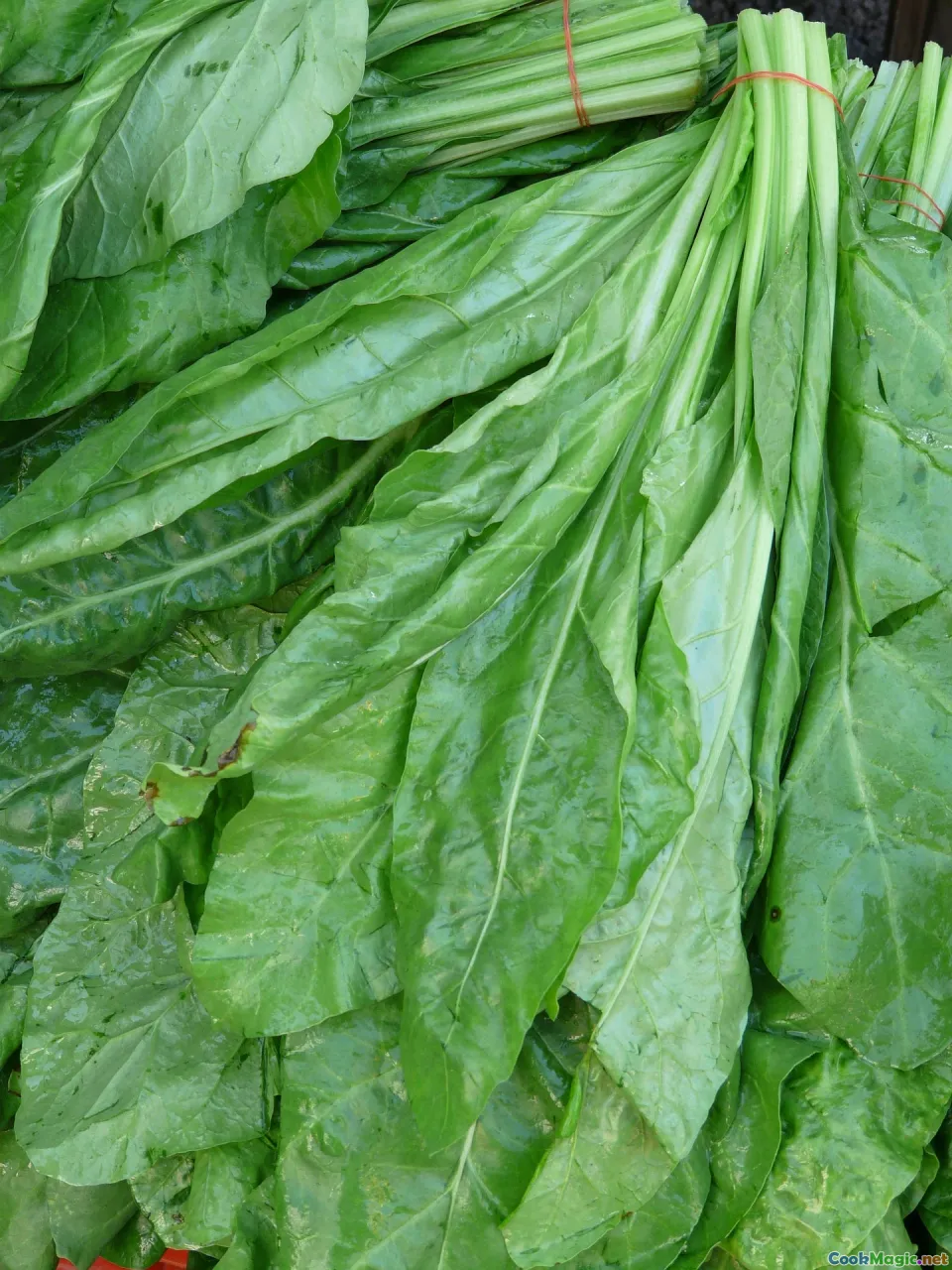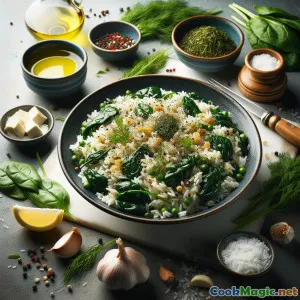
Pastel de Verduras Silvestres de Epirus: Delicia de Hierbas de Montaña Griegas
(Epirus Wild Greens Pie: Greek Mountain Herb Delight)
(0 Reseñas)0
17
agosto 11, 2025
Informar de un problema
Ingredientes
-
500 grams Verduras silvestres frescas (espinaca, acelga, ortigas, diente de león)
(Use a mix for authentic flavor; can combine with spinach)
-
4 stalks Cebollinos
(Thinly sliced; add for sweetness)
-
1 large Puerro
(White and light green parts, thinly sliced)
-
1/2 cup Perejil de hoja plana
(Finamente picado)
-
1/4 cup Eneldo
(Finely chopped (fresh only for best flavor))
-
2 tbsp Hojas de menta
(Finely chopped (fresh preferred))
-
200 grams Queso Feta
(Crumbled; authentic Greek or quality sheep’s milk feta)
-
6 tbsp Aceite de oliva virgen extra
(Divided; select robust Greek variety if possible)
-
8 pieces Hojas de masa filo
(Defrosted if frozen; thin or country-style)
-
1 tsp Sal marina
(Ajustar al gusto)
-
1/2 tsp Pimienta negra molida al momento
(Al gusto)
-
1 tbsp Semillas de sésamo
(Para decorar)
(Use a mix for authentic flavor; can combine with spinach)
(Thinly sliced; add for sweetness)
(White and light green parts, thinly sliced)
(Finamente picado)
(Finely chopped (fresh only for best flavor))
(Finely chopped (fresh preferred))
(Crumbled; authentic Greek or quality sheep’s milk feta)
(Divided; select robust Greek variety if possible)
(Defrosted if frozen; thin or country-style)
(Ajustar al gusto)
(Al gusto)
(Para decorar)
Nutrición
- Porciones: 6
- Tamaño de porción: 1 slice (180g)
- Calories: 310 kcal
- Carbohydrates: 0 g
- Protein: 9 g
- Fat: 16 g
- Fiber: 5 g
- Sugar: 4 g
- Sodium: 580 mg
- Cholesterol: 28 mg
- Calcium: 210 mg
- Iron: 3 mg
Instrucciones
-
1 - Clean and Prepare Greens:
Wash all wild greens thoroughly in cold water, draining and roughly chopping them into bite-sized pieces. Remove any tough stems.
-
2 - Sauté Aromatics:
In a large pan, heat 2 tbsp olive oil over medium heat. Add spring onions and leek. Sauté until softened and fragrant, about 5 minutes.
-
3 - Wilt the Greens:
Add prepared greens to the pan. Sauté until wilted and reduced in volume, about 6–8 minutes. Season with half the salt and pepper.
-
4 - Drain and Cool:
Transfer cooked greens to a colander and gently press to remove excess liquid. Let cool to room temperature.
-
5 - Mix Filling:
In a large bowl, combine cooled greens with parsley, dill, mint (if using), and crumbled feta. Adjust seasoning with remaining salt and pepper.
-
6 - Prepare Phyllo and Layer Base:
Brush a baking pan (about 30cm round or 26x26cm square) with olive oil. Lay 4 phyllo sheets, one at a time, brushing each with oil, allowing overhang.
-
7 - Add Filling:
Spread greens and feta filling evenly over the phyllo-lined pan.
-
8 - Top and Seal:
Cover with remaining 4 phyllo sheets, brushing each layer with oil. Fold excess phyllo inward to seal the edges. Brush top generously with more oil.
-
9 - Dress and Bake:
Score top layer gently into servings. Sprinkle sesame seeds, if desired. Bake at 180°C (350°F) for 40–45 minutes or until golden and crisp.
-
10 - Cool and Serve:
Allow pie to cool for at least 10 minutes before slicing. Serve warm or at room temperature.
Wash all wild greens thoroughly in cold water, draining and roughly chopping them into bite-sized pieces. Remove any tough stems.
In a large pan, heat 2 tbsp olive oil over medium heat. Add spring onions and leek. Sauté until softened and fragrant, about 5 minutes.
Add prepared greens to the pan. Sauté until wilted and reduced in volume, about 6–8 minutes. Season with half the salt and pepper.
Transfer cooked greens to a colander and gently press to remove excess liquid. Let cool to room temperature.
In a large bowl, combine cooled greens with parsley, dill, mint (if using), and crumbled feta. Adjust seasoning with remaining salt and pepper.
Brush a baking pan (about 30cm round or 26x26cm square) with olive oil. Lay 4 phyllo sheets, one at a time, brushing each with oil, allowing overhang.
Spread greens and feta filling evenly over the phyllo-lined pan.
Cover with remaining 4 phyllo sheets, brushing each layer with oil. Fold excess phyllo inward to seal the edges. Brush top generously with more oil.
Score top layer gently into servings. Sprinkle sesame seeds, if desired. Bake at 180°C (350°F) for 40–45 minutes or until golden and crisp.
Allow pie to cool for at least 10 minutes before slicing. Serve warm or at room temperature.
Más información sobre: Pastel de Verduras Silvestres de Epirus: Delicia de Hierbas de Montaña Griegas
Epirus Wild Greens Pie: Exploring Greece’s Rustic North
Epirus Wild Greens Pie ("Hortopita Epirotiki") holds a cherished place within Greek regional cuisine, acting as a culinary bridge connecting ancestral traditions and contemporary appetites. Coming from Epirus — a mountainous, forested corner of northwestern Greece – this savory pie evokes both the resourcefulness of its people and the luscious diversity of the Epirote landscape. Its story is written in every vibrant leaf, bold herb, and crisp, golden layer. Baked at home, served at village gatherings in the open air, or enjoyed during Orthodox Lent's meatless period, it remains deeply rooted in the Greek ethos of hospitality and respect for the land.
Cultural Significance & Traditions
In Epirus, the landscape itself shapes what emerges from its kitchens. Centuries of foraging have fostered an evolving recipe, guided by what is found in meadows and mountains: wild chard, dandelion, nettles, amaranth, chicory, sorrel, and spinach each add their voice to the filling. This renowned pie differs from the better-known spanakopita by relying more broadly on whatever greens and woodland herbs the season allows, resulting in robust complexity.
Traditionally, the phyllo for wild greens pie may be rolled out by hand — a testament to the skill and muscle of home cooks, using nothing more than flour, olive oil, a sprinkle of salt, and water to create elastic, tissue-thin sheets. Nowadays, quality store-bought phyllo is commonplace, allowing more home cooks to enjoy the pie’s beguiling crackle paired with its tender, earthy interior.
While often vegetarian, some versions may have eggs or local cheeses, whole meal flour for phyllo, or skip cheese and use more herbs during fasting periods. In each home, unique personal twists abound: a pinch more dill, a scattering of mint, a bittersweet note from dandelion.
Unique Flavors & Aspects
What distinguishes a true Epirus greens pie is its parallel dance between wild greens’ rustic edges and the gentle, salty creaminess of local feta. Parsley, dill, and mint lighten dense, iron-rich leaves, while leek and spring onion soften and sweeten earthy flavors.
When baked, the golden phyllo shatters delightfully, contrasting with the savory, herb-scented mixture within. Sesame seeds on top toast as the pie bakes, lending little pops of crunch and nutty perfume. For the true Epirote experience, serve this pie lukewarm or at room temperature with thick Greek yogurt and tangy olives.
Tips, Substitutions, and Modern Twists
- Green Selection: Substitute spinach with Swiss chard, kale, or even beet tops. Wild greens from farmer’s markets are exceptional — just avoid overly bitter varieties.
- Herbs: Experiment with wild fennel, chervil, or sorrel if available.
- Cheese: While feta is classic, combinations with graviera or manouri lend broader and milder notes.
- Phyllo Handling: Keep phyllo under a damp towel to prevent drying. Allow pie to rest before cutting for tidier slices.
- Vegan Options: Exclude feta and increase fresh herbs; use olive-based cheese alternatives, especially during Lent.
Personal Reflections
Preparing Epirus Wild Greens Pie can feel like an act of celebration — tying you to the rhythm of spring’s renewal and summer’s bounty, regardless of your location. It transforms simple, foraged or humble market vegetables into a dish that is as gracious, sustaining, and full of story as any banquet centerpiece.
Above all, this pie shines its brightest when cooked and shared generously. Whether eaten as part of a family lunch, touched up as a lunchbox delight, or starring at your Sunday table (with an Adagio of crickets in Greek mountain sun as soundscape), Epirus Wild Greens Pie will gift you a taste of Greece’s vibrant traditions and wild-hearted hospitality.




















